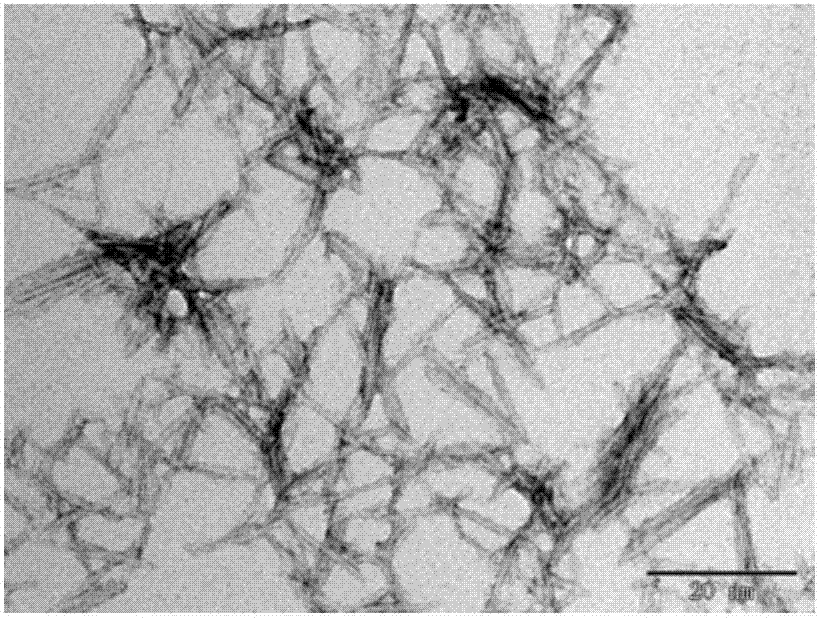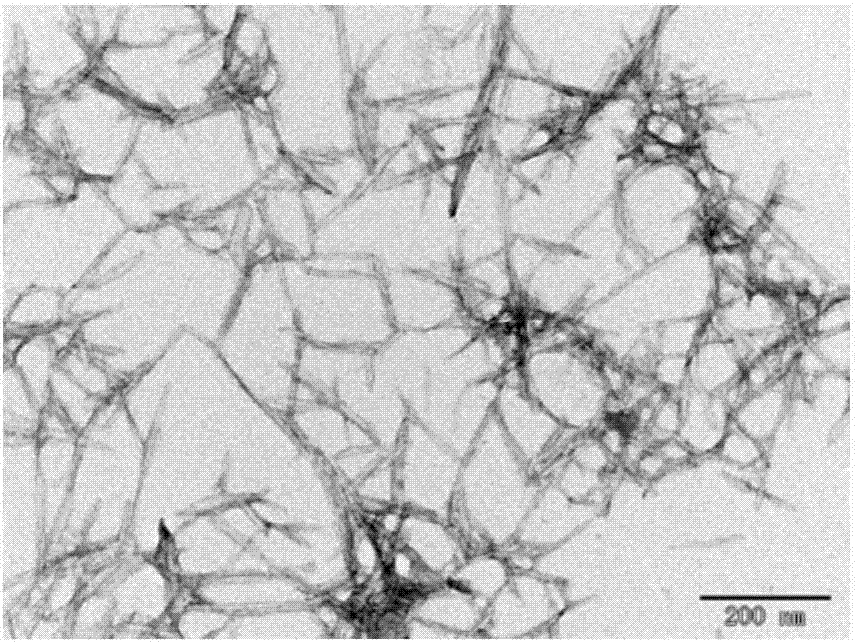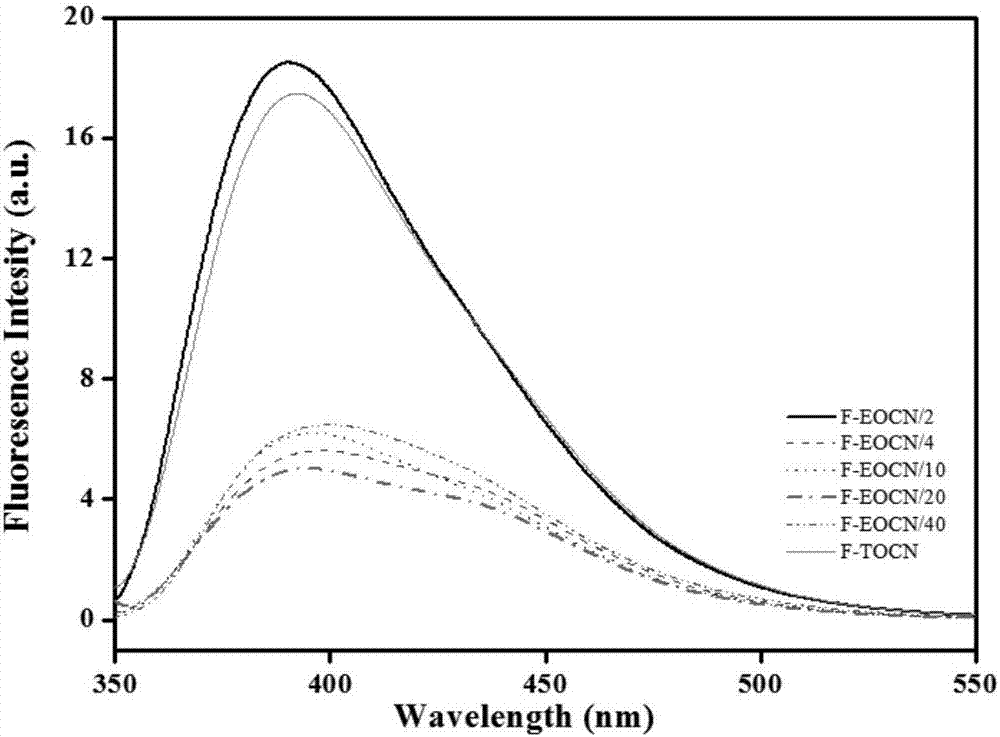Biomass-based nanoparticle as well as preparation method and application thereof
A nano- and biomass-based technology, applied in chemical instruments and methods, instruments, analytical materials, etc., can solve the problems of cumbersome processing, expensive instruments, and high cost of medicines, and achieve simple and easy-to-operate preparation processes, great application potential, detect sensitive effects
- Summary
- Abstract
- Description
- Claims
- Application Information
AI Technical Summary
Problems solved by technology
Method used
Image
Examples
Embodiment 1
[0036] A preparation method of biomass-based nanoparticles, the specific steps are as follows:
[0037] (1) Add 0.005 g of polycarboxylated cellulose nanocrystals (EOCN, carboxyl content 1 mmol / g) into 5 mL of water, ultrasonically disperse for 10 min, and then stir at room temperature until fully mixed to obtain a mixed solution;
[0038] (2) Pre-dissolve 0.02g of 1-ethyl-(3-dimethylaminopropyl)carbodiimide hydrochloride / N-hydroxysuccinimide mixture (EDC / NHS, mass ratio 1:1) The catalyst solution was obtained in 5 mL of water, and then the catalyst solution was added dropwise to the mixed solution, and reacted at 18°C for 60 minutes to obtain a reaction solution;
[0039] (3) Then add 0.0025g of 5-aminofluorescein to the reaction solution and react in the dark at 18°C for 48 hours. After the reaction, centrifuge, pour off the supernatant, and pass the precipitated product through N,N-dimethylformamide, methanol After centrifuging and washing with acetone in turn, the pre...
Embodiment 2
[0043] A preparation method of biomass-based nanoparticles, the specific steps are as follows:
[0044] (1) Add 0.15 g of polycarboxylated cellulose nanocrystals (carboxyl content 0.1 mmol / g) into 15 mL of water, ultrasonically disperse for 15 min, and then stir at room temperature until fully mixed to obtain a mixed solution;
[0045] (2) Dissolve 0.03g of 1-ethyl-(3-dimethylaminopropyl)carbodiimide hydrochloride / 4-dimethylaminopyridine mixture (EDC / DMAP, mass ratio 1:1) in advance The catalyst solution was obtained in 20mL of water, and then the catalyst solution was added dropwise to the uniformly dispersed mixed solution, and reacted at 25°C for 30 minutes to obtain a reaction solution;
[0046] (3) Then add 0.3g of 7-amino-4-methylcoumarin to the reaction solution and react in the dark at 25°C for 24 hours. After the reaction is completed, centrifuge, pour off the supernatant, and pass the precipitated product through N,N-Di After methylformamide and methanol were centrifu...
Embodiment 3
[0049] A preparation method of biomass-based nanoparticles, the specific steps are as follows:
[0050] (1) Add 0.2 g of polycarboxylated cellulose nanocrystals (carboxyl content 3 mmol / g) into 2 mL of N,N-dimethylformamide, ultrasonically disperse for 30 min, and then stir at room temperature until fully mixed to obtain a mixed solution;
[0051] (2) Dissolve 2g of 4-(4,6-dimethoxytriazin-2-yl)-4-methylmorpholine hydrochloride (DMTMM) in 40mL N,N-dimethylformamide Obtain a catalyst solution, then add the catalyst solution dropwise to the mixed solution, and react at 50°C for 10 minutes to obtain a reaction solution;
[0052] (3) Then add 2g of 7-amino-4-methylcoumarin to the reaction solution and react in the dark at 25°C for 24 hours. After the reaction, centrifuge, pour off the supernatant, and pass the precipitated product through N,N-dimethyl After centrifugation and washing with methyl formamide and methanol in sequence, the precipitated product was freeze-dried to obta...
PUM
| Property | Measurement | Unit |
|---|---|---|
| grafting amount | aaaaa | aaaaa |
| length | aaaaa | aaaaa |
| particle diameter | aaaaa | aaaaa |
Abstract
Description
Claims
Application Information
 Login to View More
Login to View More - R&D
- Intellectual Property
- Life Sciences
- Materials
- Tech Scout
- Unparalleled Data Quality
- Higher Quality Content
- 60% Fewer Hallucinations
Browse by: Latest US Patents, China's latest patents, Technical Efficacy Thesaurus, Application Domain, Technology Topic, Popular Technical Reports.
© 2025 PatSnap. All rights reserved.Legal|Privacy policy|Modern Slavery Act Transparency Statement|Sitemap|About US| Contact US: help@patsnap.com



